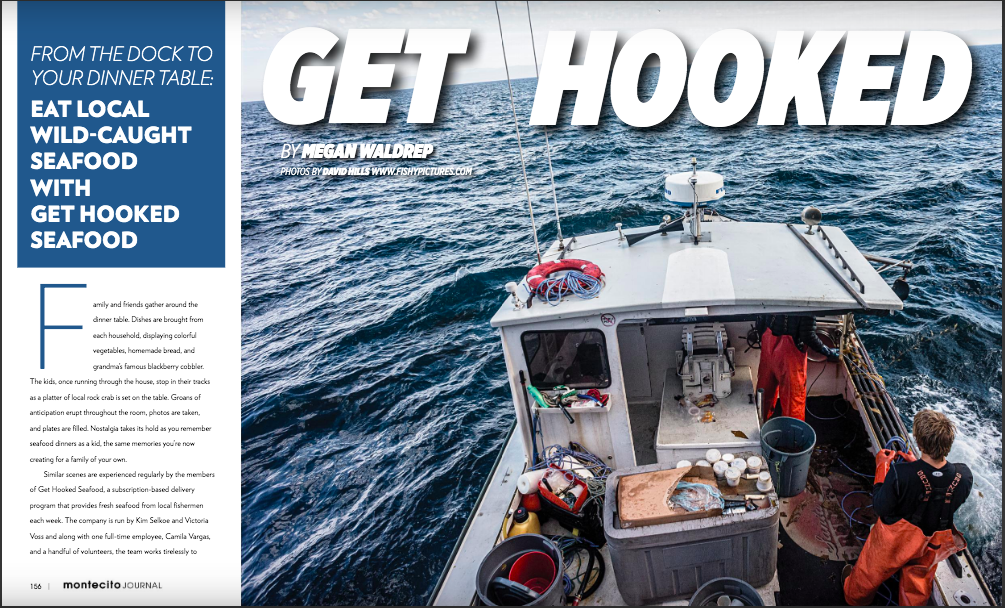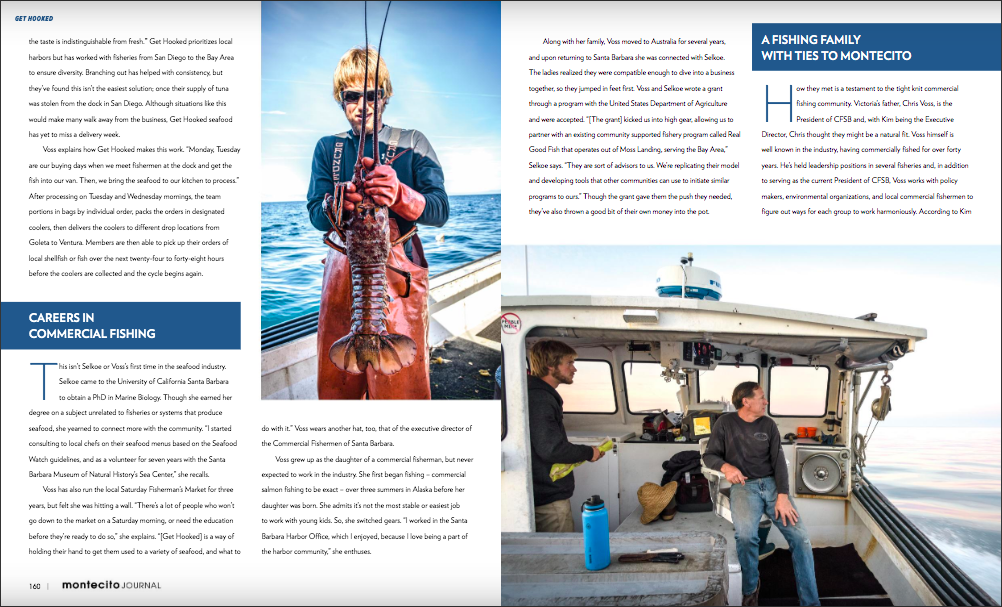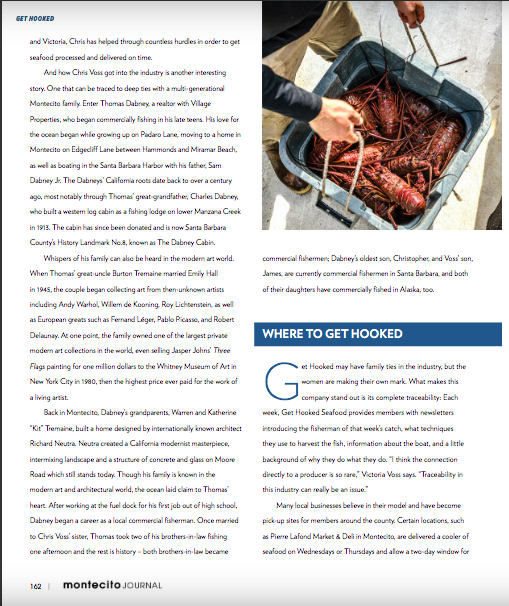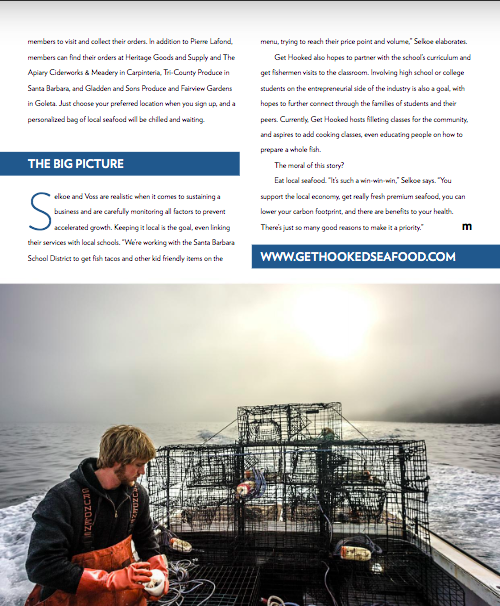by Megan Waldrep
First published in the Montecito Journal Magazine, Winter/Spring 2019/2020
Family and friends gather around the dinner table. Dishes are brought from each household, displaying colorful vegetables, homemade bread, and grandma’s famous blackberry cobbler. The kids, once running through the house, stop in their tracks as a platter of local rock crab is set on the table. Oohs and awes erupt throughout the room, photos are taken, and plates are filled. Nostalgia takes hold as you remember seafood dinners as a kid, the same memories you’re now creating for a family of your own.

Similar scenes are experienced regularly by the members of Get Hooked Seafood, a subscription-based delivery program that provides fresh seafood from local fishermen each week. The company is run by CEO Kim Selkoe and COO Victoria Voss and, along with one full-time employee, Camila Vargas, and a handful of volunteers, the team works tirelessly to provide a variety despite the unpredictable and highly perishable nature of seafood. Since its inception in December 2018, Get Hooked Seafood has offered members with a wide selection including swordfish, black cod, halibut, white sea bass, tuna, mussels, oysters, salmon, crab, ridgeback shrimp, yellowtail, Pacific sanddab, and rockfish among others. Get Hooked also strives to use under-appreciated “bycatch” species that would otherwise be discarded. (Bycatch is a fish or other marine species caught unintentionally during commercial fishing.) Members can opt-out of undesired seafood, and replacement will be added to their order instead.
Get Hooked’s program could be compared to a Community Supported Agriculture farm box subscription (or CSA), where clients buy a farm’s harvest in advance through weekly subscriptions. But, due to the complexity of seafood, the availability of certain products isn’t known until the week of deliveries. “It’s never very stable and you don’t have a bunch of inventory (to work with)” Selkoes says. “It’s highly perishable. We get it as fresh as possible, so you only have a two-day buying window, and that part is always a challenge.” To balance this inconsistency, Get Hooked delivers one main species of fresh local seafood per week. Since fishermen are mostly specialized in a specific fishery each season, Get Hooked reaches out to many different fishermen, doing their best to not repeat the same product. Freshly frozen seafood is occasionally delivered during a long stretch of bad weather, or when a fresh alternative isn’t available for those who’ve opted out of the main fish of the week. “Frozen seafood has a bad reputation because it is often frozen past its prime,” Victoria said. “But when it’s frozen at the peak of freshness, the taste is indistinguishable from fresh.” Get Hooked prioritizes local harbors first, but have worked with fisheries from San Diego to the Bay Area to ensure diversity. Branching out has helped with consistency, but they’ve found this isn’t the easiest solution; once their supply of tuna was stolen from the dock in San Diego. Although situations like this would make many walk away from the business, Get Hooked seafood has yet to miss a delivery week.

Victoria explains how Get Hooked makes this work. “Monday, Tuesday are our buying days when we meet fishermen at the dock and get the fish into our van. Then, we bring the seafood to our kitchen to process.” After processing on Tuesday and Wednesday mornings, the team portions in bags by individual order, packs the orders in designated coolers, then delivers the coolers to different drop locations from Goleta to Ventura. Members are then able to pick up their orders of local shellfish or fish over the next twenty-four to forty-eight hours before the coolers are collected and the cycle begins again.
Careers in Commercial Fishing
This isn’t Kim or Victoria’s first time in the seafood industry. Selkoe came to the University of California Santa Barbara to obtain a PhD in Marine Biology. Though she got her degree on a subject unrelated to fisheries or systems that produce seafood, she yearned to connect more with the community. “I started consulting to local chefs on their seafood menus based on the Seafood Watch guidelines, and as a volunteer for 7 years with the Santa Barbara Museum of Natural History’s Sea Center.” Kim has also run the local Saturday Fisherman’s Market for three years but felt she was hitting a wall. “There’s a lot of people who won’t go down to the market on a Saturday morning, or need the education before they’re ready to do so,” Kim explains. “(Get Hooked) is a way of holding their hand to get them used to a variety of seafood, and what to do with it.” She wears another hat, too, that of the Executive Director of the Commercial Fishermen of Santa Barbara.

Victoria grew up as the daughter of a commercial fisherman but never expected to work in the industry in this capacity. She first began fishing – commercial salmon fishing to be exact – which she enjoyed for three summers in Alaska before her daughter was born. She admits it’s not the most stable or easiest job to work with young kids. So, she switched gears. “I worked in the Santa Barbara Harbor Office, which I enjoyed because I love being a part of the harbor community,” Victoria said. She and her family moved to Australia for several years, but after moving back to Santa Barbara she was connected with Selkoe. The ladies realized they were compatible enough to dive into business together, so they jumped in feet first. Voss and Selkoe wrote a grant through a program with the United States Department of Agriculture and got accepted. “(The grant) kicked us into high gear, allowing us to partner with an existing community-supported fishery program called, Real Good Fish that operates out of Moss Landing, serving the Bay Area,” Selkoe said. “They are sort of advisors to us. We’re replicating their model and developing tools that other communities can use to initiate similar programs to ours.” Though the grant gave them the push they needed, they’ve also thrown a good bit of their own money into the pot.
A Fishing Family with Ties to Montecito
How they met is a testament to the tight-knit commercial fishing community. Victoria’s father, Chris Voss is the President of CFSB and, with Kim being the Executive Director, Chris thought they might be a natural fit. Voss himself is well known in the industry, having commercially fished for over forty years. He’s held leadership positions in several fisheries and, in addition to being the current President of CFSB, Voss works with policymakers, environmental organizations, and local commercial fishermen to figure out ways for each group to work harmoniously. According to Kim and Victoria, Chris has helped through countless hurdles and has been the extra muscle to get seafood processed and delivered on time.

And how Chris got into the industry is another interesting story. One that can be traced to deep ties with a multi-generational Montecito family. Enter Thomas Dabney, a realtor with Village Properties, who began commercially fishing in his late teens. His love for the ocean began while growing up on Padaro Lane, moving to a home in Montecito on Edgecliff Lane between Hammonds and Miramar Beach, as well as boating in the Santa Barbara Harbor with his father, Sam Dabney Jr. The Dabney’s California roots date back to over a century, most notably through Thomas’ great-grandfather, Charles Dabney, who built a western log cabin as a fishing lodge on lower Manzana Creek in 1913. (The cabin has since been donated and became Santa Barbara County’s History Landmark No.8, known as The Dabney Cabin.) Whispers of his family can also be heard in the modern art world: When Thomas’ great-uncle Burton Tremaine married Emily Hall in 1945, the couple began collecting art from, then, unknown artists including Andy Warhol, Willem de Kooning, Roy Lichtenstein, as well as European greats such as Fernand Léger, Pablo Picasso, and Robert Delaunay. At one point, the family-owned one of the largest private modern art collections in the world, even selling Jasper Johns’ Three Flags painting for one million dollars to the Whitney Museum of Art in New York City in 1980, then the highest price ever paid for the work of a living artist. Back in Montecito, Dabney’s grandparents, Warren and Katherine “Kit” Tremaine, built a home designed by internationally known architect, Richard Neutra. Neutra created a California modernist masterpiece, intermixing landscape and a structure of concrete and glass on Moore Road which still stands today. Though his family is known in the modern art and architectural world, the ocean laid claim to Thomas’ heart. After working at the fuel dock for his first job out of high school, Dabney began a career as a local commercial fisherman. Once married to Chris Voss’ sister, Thomas took two of his brother-in-laws fishing one afternoon and the rest is history – both brothers-in-law became commercial fishermen; Dabney’s oldest son, Christopher, and Voss’ son, James, are currently commercial fishermen in Santa Barbara; and both of their daughters have commercially fished in Alaska, too.
Where to Get Hooked
Get Hooked may have family ties in the industry, but the women are making their own mark. What makes this company stand out is it’s complete traceability: each week, Get Hooked Seafood provides members with newsletters introducing the fisherman of that week’s catch, what techniques they use to harvest the fish, information about the boat, and a little background of why they do what they do. “I think the connection directly to a producer is so rare,” Victoria says. “Traceability in this industry can really be an issue.” Many local businesses believe in their model and have proudly become pick-up sites for members around the county. Certain locations, such as Pierre Lafond Market & Deli in Montecito, are delivered a cooler of seafood on Wednesday or Thursday and allow a two-day window for members to visit and collect their orders. In addition to Pierre Lafond, members can find their orders at Heritage Goods and Supply and The Apiary Ciderworks & Meadery in Carpinteria, Tri-County Produce in Santa Barbara, and Gladden and Sons Produce and Fairview Gardens in Goleta. Just choose your preferred location when you sign up, and a personalized bag of local seafood will be chilled and waiting.

The Big Picture
Selkoe and Voss are realistic when it comes to sustaining a business, and are carefully monitoring all factors to prevent accelerated growth. Keeping it local is the goal, even linking their services with local schools. “We’re working with the Santa Barbara School District to get fish tacos and other kid-friendly items on the menu, trying to reach their price point and volume,” Kim said. Get Hooked desires to partner with the school’s curriculum and get fishermen visits to the classroom. Involving high school or college students on the entrepreneurial side of the industry is also a goal, with hopes to further connect through the families of students and their peers. Currently, Get Hooked host filleting classes for the community, and aspires to add cooking classes, even educating people on how to prepare a whole fish.
The moral of this story? Eat local seafood. “It’s such a win-win-win,” Kim said. “You support the local economy, get really fresh premium seafood, you can lower your carbon footprint, and there are benefits to your health. There are just so many good reasons to make it a priority.”

Pingback: Wendy Foster: A Fashion Icon Lets Her Guard Down : Megan Waldrep